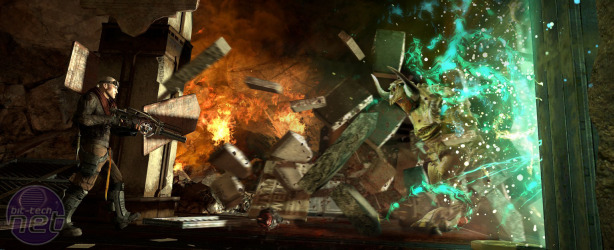
Red Faction: Armageddon Review
Publisher: THQPlatform: PC, Xbox 360, PlayStation 3
UK Price (as reviewed) £24.49 (inc VAT)
US Price (as reviewed): $40.99 (ex tax)
One of the metrics we informally use for assessing the quality of a game is a simple count of how many people come over and watch the reviewer play, or who ask for ‘just a quick go’. On this front, Red Faction: Armageddon is clearly a stellar title, having proved itself capable of enthralling passers-by with ease thanks to its explosive weaponry and highly destructible terrain. It can be great fun to play, hilarious to watch and genuinely challenging in a number of unusual and unexpected ways.
At the same time, however, Red Faction: Armageddon is also a very dreary, unimaginative and disappointing experience. It’s dull, samey and so predictable that you could probably follow the plot even if you played with no sound and your eyes half-closed.
The more we played Red Faction: Armageddon, the quicker we found ourselves alternating between these two opposing viewpoints. It’s good, but it’s also bad; fun, but also boring; a marvel built out of mediocrity.
The simplest way to explain Armageddon’s strengths and weaknesses would be describe it as Just Cause 2 in a desert. Like Just Cause 2, Armageddon gives you some fascinating tools to play with, but it differs in that it doesn’t provide a compelling space in which to use them. Where Just Cause 2 let you tie planes together mid-flight and parasail behind police speedboats, Red Faction limits you to tearing down the same scaffolding again and again.
Ultimately, it’s a fault of the fiction and the setting. In terms of the design and pacing, Armageddon is near flawless, quickly shoving interesting guns in your direction and letting you run loose through its Martian caverns. If the game was personified then it would appear as a fussy and paranoid version of Mary Poppins, rummaging through a carpet bag and loading you up with equipment you might need – ‘Here’s a magnet gun, for tearing buildings down’ she would say. ‘Better take the singularity cannon too, for collapsing structures on a single point. And you’ll need a nanite beam, obviously…’
These devices and more are thrust into your open arms with alarming and gleeful rapidity, brightening an otherwise drab world of grey caves and generic space-aliens with escalating levels of interaction and destructive potential. The first few hours are unexpectedly engaging as a result, even with needlessly regular cutscenes punctuating your exploration and telling the boring story of Darius Mason.
Check the Trailers Section for more
Long story short: Mason is tricked by baddy Adam Hale and his baddy army into unleashing a horde of aliens into Mars’ caverns – where most of the population now lives.
Eventually, however, the drudgery of the setting takes its toll and you start yearning for wide-open spaces, more complex targets than generic sci-fi shantytowns and a chance to stretch your imagination's legs.
The romantic way of expressing this would be to imply that Armageddon is so good at creating an oppressive, bleak subterrania that you empathise closely with the characters and suffer cabin fever on their behalf. A more honest explanation would be that Mars is visually a very boring place, and that even remains true when you’re able to rip it apart with a gun that fires miniature black holes.

MSI MPG Velox 100R Chassis Review
October 14 2021 | 15:04










Want to comment? Please log in.